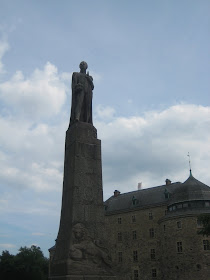




 200 years ago on this very day Jean-Baptiste Bernadotte, Marshal of the French Empire and Sovereign Prince of Pontecorvo, was elected crown prince of Sweden by the four estates assembled in the Church of St Nicolai in Örebro and today King Carl Gustaf, Queen Silvia, Crown Princess Victoria, Prince Daniel, Prince Carl Philip and Princess Madeleine take part in the celebrations in Örebro, including a celebratory mass in that church. The day began with a visit to Stjernsund Palace in the rain. For Prince Daniel these are his first public engagements after his wedding and very appropriately they bring him back to the town where both he and the Bernadotte dynasty were born.
200 years ago on this very day Jean-Baptiste Bernadotte, Marshal of the French Empire and Sovereign Prince of Pontecorvo, was elected crown prince of Sweden by the four estates assembled in the Church of St Nicolai in Örebro and today King Carl Gustaf, Queen Silvia, Crown Princess Victoria, Prince Daniel, Prince Carl Philip and Princess Madeleine take part in the celebrations in Örebro, including a celebratory mass in that church. The day began with a visit to Stjernsund Palace in the rain. For Prince Daniel these are his first public engagements after his wedding and very appropriately they bring him back to the town where both he and the Bernadotte dynasty were born.The celebrations will include a speech by King Carl Gustaf at the Iron Square, close to the monument to his ancestor Carl XIV Johan which stands on the edge of the Central Park outside Örebro Castle.
The statue was erected following a 1913 initiative of Erik B:son Lilliehöök, who had hoped it could be unveiled in February 1918, a century after Carl Johan succeeded to the thrones of Sweden and Norway. It was however not until sixteen months later that the monument was unveiled.
Four of Sweden’s most prominent sculptors – Carl Milles, Christian Eriksson, Teodor Lundberg and C. J. Eld – had been invited to take part in a competition for the monument, but thirteen other artists also entered the contest, which was in the end won by an equestrian statue by Teodor Lundberg and the architect Aron Johansson. Yet the commission was eventually given to the artist who had come fourth in the competition – the comparatively little-known, virtually autodidact Alfred Ohlsson (1868-1940).
The monument is made of Vätö granite and was carved in Roslagen, arriving in Örebro by train in early June 1919. It was unveiled on 12 June 1919 by King Gustaf V, who had come to Örebro accompanied by his brothers Prince Carl and Prince Eugen (who was Duke of Nerike, the landscape in which Örebro is located), Prime Minister Nils Edén, Foreign Minister Johannes Hellner and other notabilities.
The monument is in my opinion one of the best statues of Carl XIV Johan. It shows the King standing, wearing military uniform and a cloak. With his left hand he holds the royal crown at hip level, while the right hand clutches his sword to his chest, symbolising that Carl Johan, unlike most kings, owed his elevation to the status of a monarch not to his ancestry but to his military deeds.
This morning it was discovered that someone during the night has vandalised the plinth by spraying the words “Opposition? That is treason!” onto it. King Carl Johan is famously alledged to have said “Opposition, that is conspiracy!” so this also appears to be a misquote.
What an interesting article. I am considering the artistic merit of the work as much as the historic significance of the subject.
ReplyDeleteI am glad you included the date of the statue and the material. The statue has simplicity and is slightly stylized, giving it a preview of 20th century modernism that was especially important in terms of Scandinavian modern design. This excellence and clarity of nordic design became widely admired and imitated throughout the world, and persists to this day.
It is unusual how the pedestal is so tall and elongated, somewhat suggesting a triumphal column or pier. I think it very successfully combines references to history, heritage, and the past, while being fresh and crisp in the artistic approach.
Thank you.